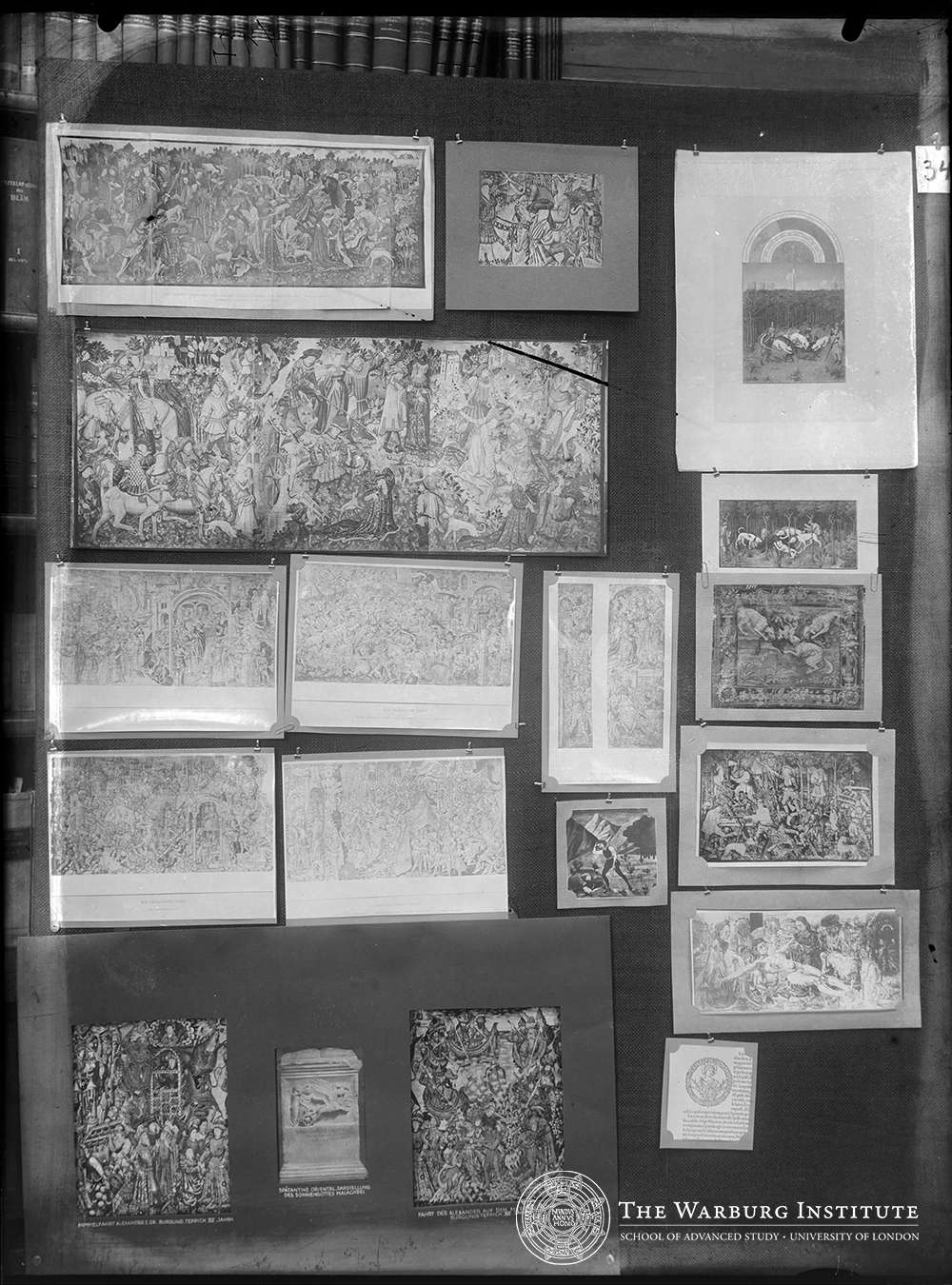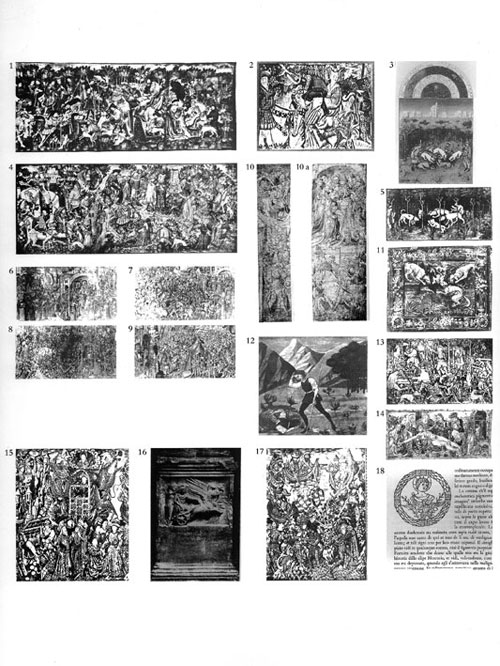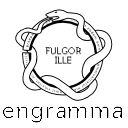Mnemosyne Atlas 34
Trame antiche: gli arazzi come veicolo di tradizione
L’arazzo come medium per l’espressione della vitalità dell’Antico: scene contemporanee (caccia, feste, lavoro contadino) come contrappunto realistico alla “vita in movimento” (pathos dionisiaco); scene antiche (la guerra di Troia, il mito dell’ascesa al cielo di Alessandro Magno) come imprese di cavalieri e principi. Temi cristiani e temi pagani (Narciso, Deposizione di Cristo) come soggetti ugualmente richiesti per la rappresentazione sugli arazzi, tra Nord e Sud.
Ancient threads: tapestries as a vehicle of tradition
Tapestry as a medium to express the vitality of Antiquity: contemporary scenes (hunting, feasting, farming) as a realistic counterpoint to ‘life in motion’ (Dionysiac pathos); scenes from antiquity (the Trojan war, the myth of Alexander the Great’s ascent to heaven) as enterprises of knights and princes. Both Christian and pagan themes (e.g. Narcissus, Deposition of Christ) are equally requested subjects for representation on tapestries, from North to the South.

Appunti di Aby Warburg (1929)
Arazzo
Arazzo.
Appunti di Aby Warburg e collaboratori (1929)
Teppich als Vehikel. Themen: Jagd und Vergnügen. Arbeitende Bauern. Antike im Zeitgewand (Trojan.Krieg. Alexander) = Auffhart. Narziss und Grablegung als bestellte Teppichthemen?
Arazzo come veicolo. Temi: caccia e svaghi. Contadini al lavoro. Antichi in vesti del tempo (guerra troiana; Alessandro) = ascensione. Narciso e Deposizione come temi commissionati per arazzi?
Appunti di Gertrud Bing (1940 ca)
Beitrag des Nordens. Teppichstil. Diese Tafel verstehe ich im einzelnen gar nicht. Stehen die ersten 3 Teppiche zür “Höfisches Leben im Freien”? Die Hundegruppe bei des Eberjagd kommt aus der Antike. Die “arbeitenden Bauern” darunter siehe Ges. Schr. Die Zeichnungen sind Hist. Torj. und gehören zu den Teppichen im V. + A. Mus. Alexander siehe Ges. Sch. Aber was bedeutet der Narziss und die Grablegung in diesem Zusammenhange, und wie hängt das Ganze überhaupt zusammen?
Contributo del Nord. Stile dell’arazzo. Non capisco affatto questa Tavola nel dettaglio. I primi tre arazzi rappresentano la “vita cortese all’aria aperta”? Il gruppo dei cani nella caccia al cinghiale proviene dall’Antichità. In basso, i “contadini al lavoro”, vedi Gesammelte Schriften. I disegni sono dell’Historia Troiana e fanno parte degli arazzi presenti al Victoria and Albert Museum. Per Alessandro, vedi Gesammelte Schriften. Ma cosa significano in questo contesto il Narciso e la Deposizione, e come si collega il tutto?
Notes by Aby Warburg (1929)
Arazzo
Tapestry.
Notes by Aby Warburg and coll. (1929)
Teppich als Vehikel. Themen: Jagd und Vergnügen. Arbeitende Bauern. Antike im Zeitgewand (Trojan.Krieg. Alexander) = Auffhart. Narziss und Grablegung als bestellte Teppichthemen?
Tapestries as vehicles. Themes: hunting and amusements. Farmers at work. Antiquity in contemporary clothing (Trojan War, Alexander the Great)= ascent. Narcissus and the Entombment as themes for the commissioned tapestries?
Notes by Gertrud Bing (ca. 1940)
Beitrag des Nordens. Teppichstil. Diese Tafel verstehe ich im einzelnen gar nicht. Stehen die ersten 3 Teppiche zür “Höfisches Leben im Freien”? Die Hundegruppe bei des Eberjagd kommt aus der Antike. Die “arbeitenden Bauern” darunter siehe Ges. Schr. Die Zeichnungen sind Hist. Torj. und gehören zu den Teppichen im V. + A. Mus. Alexander siehe Ges. Sch. Aber was bedeutet der Narziss und die Grablegung in diesem Zusammenhange, und wie hängt das Ganze überhaupt zusammen?
Contribution of the North. Tapestry style. I do not understand at all this Panel in detail. The first three tapestries represent ‘courtly life in the open air’. The group of dogs hunting wild boar comes from Antiquity. Below, peasants at work, see Gesammelte Schriften. The drawings are from the Historia Troiana and are part of the tapestries in the Victoria and Albert Museum. For Alexander, see Gesammelte Schriften. But what do the Narcissus and the Deposition mean in this context, and how does it all relate?

1. Caccia all'orso e al cinghiale, arazzo dalla serie degli arazzi a soggetto venatorio del Devonshire, Tournai, 1425-1450 ca., London, Victoria and Albert Museum.
2. Cavalieri, frammento di arazzo, Tournai, 1450 ca., Saumur, da Notre Dame de Nantilly.
3. Caccia al cervo nella foresta di Vincennes, illustrazione del mese di dicembre, miniatura da Barthélemy d'Eyck detto Maestro di René, Très Riches Heures de Jean de Berry, 1440 ca., Chantilly, Musée Condè, Ms. 65, fol 12v.
4. Scena di caccia col falcone, arazzo dalla serie degli arazzi a soggetto venatorio del Devonshire, Tournai, 1425-1450, London, Victoria and Albert Museum.
5. Caccia al cinghiale, miniatura da un Libro d'Ore fiammingo, sec. XV (?).
6. La distruzione di Troia; l'invio di Antenore in Grecia; il giudizio di Paride, da Pasquier e Jean Grenier, Storie della Guerra di Troia, cartoni per arazzo, Tournai 1475 ca., Paris, Musée du Louvre.
7. La quarta battaglia della guerra troiana: cattura del re Toante; nella camera della bellezza, da Pasquier e Jean Grenier, Storie della guerra di Troia, cartoni per arazzo, Tournai 1475 ca., Paris, Musée du Louvre.
8. La caduta di Troia, da Pasquier e Jean Grenier, Storie della guerra di Troia, cartoni per arazzo, Tournai 1475 ca., Paris, Musée du Louvre.
9. L'arrivo di Pentesilea; amazzonomachia; Pirro viene cinto con la spada; Pirro in battaglia, da Pasquier e Jean Grenier, Storie della guerra di Troia, cartoni per arazzo, Tournai 1475 ca., Paris, Musée du Louvre.
10. Dodicesima battaglia: morte di Palamede; rifiuto di Achille; Ettore saluta Andromaca; Ettore viene armato; entrata di Ettore in battaglia, da Pasquier e Jean Grenier, Storie della guerra di Troia, cartoni per arazzo, Tournai 1475 ca., Paris, Musée du Louvre.
11. Caccia al cinghiale, arazzo fiammingo, sec. XV-XVI (?).
12. Narciso, Maestro del giudizio di Paride, dipinto su cassone, seconda metà del sec. XV, Wien, Lanckoronski Sammlung.
13. Contadini al lavoro, arazzo delle Fiandre, sec. XV, Paris, Musée des Arts Decoratifs.
14. Deposizione, arazzo da un cartone di Cosmè Tura, 1475 ca., Köln, Sig. Neven-Dumont.
15. Ascesa al cielo di Alessandro Magno, arazzo borgognone, sec. XV [didascalia della KBW], arazzo fiammingo, 1459 ca., Roma, Palazzo Doria-Pamphili (ora: Genova, Palazzo del Principe).
16. Raffigurazione orientale tardoantica del dio del sole Malachbel [didascalia della KBW], rilievo con il dio Sole, incoronato dalla Vittoria, che si innalza su un carro trainato da grifi, altare del dio solare Malachbel da Palmira, 40-70 d.C., Roma, Musei Capitolini.
17. Discesa di Alessandro Magno al fondo del mare, arazzo borgognone, sec. XV [didascalia della KBW], arazzo fiammingo, 1459 ca., Roma, Palazzo Doria-Pamphili (ora: Genova, Palazzo del Principe).
18. Medaglione con busto di Apollo, illustrazione da Francesco Colonna, Hypnerotomachia Poliphili, xilografia, Venezia (Aldo Manuzio) 1499, p. 94.
1. The Devonshire Hunting Tapestry (formerly belonged to the Dukes of Devonshire): Boar and Bear Hunt, tapestry, 1430-1450. Tapestry. London, Victoria and Albert Museum.
2. Hunting Scene, fragment of larger tapestry, 1425-1450 c. Saumur, Church of Notre Dame de Nantilly.
3. Barthélemy d’Eyck, December: Boar Hunt, tempera on vellum, 1440 c. Chantilly, Musée Condé, Ms. 65, fol. 12v. From: Très Riches Heures du Duc de Berry.
4. The Devonshire Hunting Tapestry (formerly belonged to the Dukes of Devonshire): Falconry, tapestry, 1430-1450. Tapestry. London, Victoria and Albert Museum.
5. Bour Hunt, manuscript illumination from an unidentified Book of Hours. Probably 1440s.
6. Coëtivy master, The Trojan War (one of the 8 cartoons for the series of tapestries by Pasquier Grenier): Antenor sent to Greece as a messenger and the Judgement of Paris, pen and watercolor highlights on cartoon, 1475-1490. Paris, Musée du Louvre, Département des Arts graphiques.
7. Coëtivy master, The Trojan War (one of the 8 cartoons for the series of tapestries by Pasquier Grenier): Fourth battle, Capture of King Thoas and beauty’s room, pen and watercolor highlights on cartoon, 1475-1490. Paris, Musée du Louvre, Département des Arts graphiques.
8. Coëtivy master, The Trojan War (one of the 8 cartoons for the series of tapestries by Pasquier Grenier): Destruction of Troy , pen and watercolor highlights on cartoon, 1475-1490. Paris, Musée du Louvre, Département des Arts graphiques.
9. Coëtivy master, The Trojan War (one of the 8 cartoons for the series of tapestries by Pasquier Grenier): Arrival of Penthesilea and the battle of the amazons, pen and watercolor highlights on cartoon, 1475-1490. Paris, Musée du Louvre, Département des Arts graphiques.
10. Coëtivy master, The Trojan War (one of the 8 cartoons for the series of tapestries by Pasquier Grenier): Achilles in front of his tent, Hector and Andromeda, Paris killing Palamedes, pen and watercolor highlights on cartoon, 1475-1490. Paris, Musée du Louvre, Département des Arts graphiques.
11. Boar Hunt , fragment of a larger tapestry, XV or XVI century. Whereabouts unknown.
12. Master of the judgment of Paris, Narcissus, oil on cassone’s panel, XV century. Vienna, Collection Count Lanckoronski.
13. Pasquier Grenier, Woodcutters, tapestry, before 1462. Paris, Musée des Arts Décoratifs.
14. Design attributed co Cosme Tura and woven in the workshop of Rubinetto di Francia, Lamentation over the Body of the Dead Christ, wool and silk tapestry, 1474-1475 ca. Lugano, Museo Thyssen-Bornemisza National Museum.
15. Alexander Tapestry. Detail of the second tapestry, titled The Eastern Campaigns, tapestry, 1460 c. Genova, Villa del Principe.
16. The Sun God on a Chariot with Victory. Altar of the Sol Sanctissimus (Malachbel) commissioned by Tiberius Claudius Felix and his wife Claudia Helpis, marble relief, AD 40-70. Rome, Musei Capitolini.
17. Alexander Tapestry. Detail of the second tapestry, titled The Eastern Campaigns, tapestry, 1460 c. Genova, Villa del Principe.
18. Medallion with the Bust of Apollo, woodcut. From: Francesco Colonna, Hypncrocomachia Poliphili, Venice: Aldus Manutius, 1499, p. 94.


34_1 | Arazzo di caccia del Devonshire: caccia all’orso e al cinghiale, arazzo fiammingo (378,4 x 1023 cm.), 1430-1450. Londra, Victoria and Albert Museum.
In Tavola: riproduzione fotografica.
34_1 | The Devonshire Hunting Tapestry (formerly belonged to the Dukes of Devonshire): Boar and Bear Hunt, tapestry (378.4 x 1023 cm.), 1430-1450. Tapestry. London, Victoria and Albert Museum.
In the panel: photographic reproduction.

34_2 | Scena di caccia, frammento di arazzo, 1425-1450 ca. Saumur, Chiesa di Notre Dame de Nantilly.
In Tavola: riproduzione fotografica.
34_2| Hunting Scene, fragment of larger tapestry, 1425-1450 c. Saumur, Church of Notre Dame de Nantilly.
In the panel: photographic reproduction.

34_3 | Barthélemy d’Eyck, Dicembre: caccia al cervo nella foresta di Vincennes, tempera su pergamena (22,5 x 13,6 cm.), 1440 c. Chantilly, Musée Condé, Ms. 65, fol. 12v., Tratto da: Très Riches Heures de Jean de Berry.
In Tavola: riproduzione fotografica.
34_3 | Barthélemy d’Eyck, December: Boar Hunt, tempera on vellum (22.5 x 13.6 cm.), 1440 c. Chantilly, Musée Condé, Ms. 65, fol. 12v. From: Très Riches Heures du Duc de Berry.
In the panel: photographic reproduction.

34_4 | Arazzo di caccia del Devonshire: caccia col falcone, arazzo fiammingo (445 x 1075,9 cm.), 1430-1450. Londra, Victoria and Albert Museum.
In Tavola: riproduzione fotografica.
34_4 | The Devonshire Hunting Tapestry (formerly belonged to the Dukes of Devonshire): Falconry, tapestry (445 x 1075.9 cm.), 1430-1450. Tapestry. London, Victoria and Albert Museum.
In the panel: photographic reproduction.

34_5 | Caccia al cinghiale, miniatura da un Libro d’Ore fiammingo, sec. XV (?).
In Tavola: riproduzione fotografica.
34_5 | Bour Hunt, manuscript illumination from an unidentified Book of Hours. Probably 1440s.
In the panel: photographic reproduction.

34_6 | Maestro di Coëtivy, La guerra di Troia (fa parte di una serie di 8 cartoni preparatori per gli arazzi di Pasquier Grenier): Antenore inviato in Grecia come messaggero e il giudizio di Paride, inchiostro e acquerelli su cartone (30 x 57,8 cm.), 1475-1490. Parigi, Musée du Louvre, Département des Arts graphiques.
In Tavola: riproduzione fotografica.
34_6 | Coëtivy master, The Trojan War (one of the 8 cartoons for the series of tapestries by Pasquier Grenier): Antenor sent to Greece as a messenger and the Judgement of Paris, pen and watercolor highlights on cartoon (30 x 57.8 cm.), 1475-1490. Paris, Musée du Louvre, Département des Arts graphiques.
In the panel: photographic reproduction.

34_7 | Maestro di Coëtivy, La guerra di Troia (fa parte di una serie di 8 cartoni preparatori per gli arazzi di Pasquier Grenier): quarta battaglia, cattura del re Thoas e la stanza della bellezza, inchiostro e acquerelli su cartone (30 x 57,7 cm.), 1475-1490. Parigi, Musée du Louvre, Département des Arts graphiques.
In Tavola: riproduzione fotografica.
34_7 | Coëtivy master, The Trojan War (one of the 8 cartoons for the series of tapestries by Pasquier Grenier): Fourth battle, Capture of King Thoas and beauty’s room, pen and watercolor highlights on cartoon (30 x 57.7 cm.), 1475-1490. Paris, Musée du Louvre, Département des Arts graphiques.
In the panel: photographic reproduction.

34_8 | Maestro di Coëtivy, La guerra di Troia (fa parte di una serie di 8 cartoni preparatori per gli arazzi di Pasquier Grenier): distruzione di Troia, inchiostro e acquerelli su cartone (30,7 x 57,6 cm.), 1475-1490. Parigi, Musée du Louvre, Département des Arts graphiques.
In Tavola: riproduzione fotografica.
34_8 | Coëtivy master, The Trojan War (one of the 8 cartoons for the series of tapestries by Pasquier Grenier): Destruction of Troy , pen and watercolor highlights on cartoon (30,7 x 57.6 cm.), 1475-1490. Paris, Musée du Louvre, Département des Arts graphiques.
In the panel: photographic reproduction.

34_9 | Maestro di Coëtivy, La guerra di Troia (fa parte di una serie di 8 cartoni preparatori per gli arazzi di Pasquier Grenier): arrivo di Pentesilea e la battaglia delle amazzoni, inchiostro e acquerelli su cartone (30, 7 x 57,5 cm.), 1475-1490. Parigi, Musée du Louvre, Département des Arts graphiques.
In Tavola: riproduzione fotografica.
34_9 | Coëtivy master, The Trojan War (one of the 8 cartoons for the series of tapestries by Pasquier Grenier): Arrival of Penthesilea and the battle of the amazons, pen and watercolor highlights on cartoon (30.7 x 57.5 cm.), 1475-1490. Paris, Musée du Louvre, Département des Arts graphiques.
In the panel: photographic reproduction.

34_10 e 10b | Maestro di Coëtivy, La guerra di Troia (fa parte di una serie di 8 cartoni preparatori per gli arazzi di Pasquier Grenier): Achille di fronte alla sua tenda, Ettore e Andromaca e Paride uccidendo Palamede, inchiostro e acquerelli su cartone (30,8 x 17,5 cm.), 1475-1490. Parigi, Musée du Louvre, Département des Arts graphiques.
In Tavola: riproduzione fotografica.
34_10 e 10b | Coëtivy master, The Trojan War (one of the 8 cartoons for the series of tapestries by Pasquier Grenier): Achilles in front of his tent, Hector and Andromaca, Paris killing Palamedes, pen and watercolor highlights on cartoon (30.8 x 17.5 cm.), 1475-1490. Paris, Musée du Louvre, Département des Arts graphiques.
In the panel: photographic reproduction.

34_11 | Caccia al cinghiale, frammento di un arazzo fiammingo, sec. XV-XVI. Collocazione ignota.
In Tavola: riproduzione fotografica.
34_11 | Boar Hunt , fragment of a larger tapestry, XV or XVI century. Whereabouts unknown.
In the panel: photographic reproduction.

34_12 | Maestro del giudizio di Paride, Narciso, olio su pannello di cassone (43 x 41 cm.), seconda metà del XV sec. Vienna, Lanckoronski Sammlung.
In Tavola: riproduzione fotografica.
34_12 |Master of the judgment of Paris, Narcissus, oil on cassone’s panel (43 x 41 cm.), XV century. Vienna, Collection Count Lanckoronski.
In the panel: photographic reproduction.

34_13 | Pasquier Grenier, Contadini tagliando la legna in un bosco abitato da belve feroci, arazzo delle Fiandre (320 x 510 cm.), prima del 1462, Paris, Musée des Arts Décoratifs.
In Tavola: riproduzione fotografica.
34_13 | Pasquier Grenier, Woodcutters, tapestry (320 x 510 cm.), before 1462. Paris, Musée des Arts Décoratifs.
In the panel: photographic reproduction.

34_14 | Rubinetto di Francia su disegno di Cosme Tura, Lamentazione, arazzo di lana e seta (97 x 206 cm.), 1474-1475 ca. Lugano, Museo Thyssen-Bornemisza.
In Tavola: riproduzione fotografica.
34_14| Design attributed co Cosme Tura and woven in the workshop of Rubinetto di Francia, Lamentation over the Body of the Dead Christ, wool and silk tapestry (97 x 206 cm.), 1474-1475 ca. Lugano, Museo Thyssen-Bornemisza National Museum.
In the panel: photographic reproduction.

34_15 | Arazzo di Alessandro Magno. Maturità di Alessandro: l'ascensione in cielo su un velivolo trainato da grifoni, arazzo fiammingo (415 x 985 cm.), 1460 ca. Genova, Palazzo del Principe.
In Tavola: riproduzione fotografica.
34_15 | Alexander Tapestry. Detail of the second tapestry, titled The Eastern Campaigns, tapestry (415 x 985 cm.), 1460 c. Genova, Villa del Principe.
In the panel: photographic reproduction.

34_16 | Altare tardoantico del dio del sole Malachbel commissionato da Tiberius Claudius Felix e sua moglie Claudia Helpis, rilievo in marmo (84,5 × 53 × 53 cm.), 40-70 d.C. Roma, Musei Capitolini.
In Tavola: riproduzione fotografica.
34_16 | The Sun God on a Chariot with Victory. Altar of the Sol Sanctissimus (Malachbel) commissioned by Tiberius Claudius Felix and his wife Claudia Helpis, marble relief (84.5 × 53 × 53 cm.), AD 40-70. Rome, Musei Capitolini.
In the panel: photographic reproduction.

34_17 | Arazzo di Alessandro Magno. Maturità di Alessandro: discesa di Alessandro Magno al fondo del mare, arazzo fiammingo (415 x 985 cm.), 1460 ca. Genova, Palazzo del Principe.
In Tavola: riproduzione fotografica.
34_17 | Alexander Tapestry. Detail of the second tapestry, titled The Eastern Campaigns, tapestry (415 x 985 cm.), 1460 c. Genova, Villa del Principe.
In the panel: photographic reproduction.

34_18 | Medaglione con busto di Apollo, xilografia (25 x 20cm.). In Francesco Colonna, Hypncrocomachia Poliphili, Venezia: Aldus Manutius, 1499, p. 94.
In Tavola: riproduzione fotografica.
34_18 | Medallion with the Bust of Apollo, woodcut (25 x 20cm.). From: Francesco Colonna, Hypncrocomachia Poliphili, Venice: Aldus Manutius, 1499, p. 94.
In the panel: photographic reproduction.

